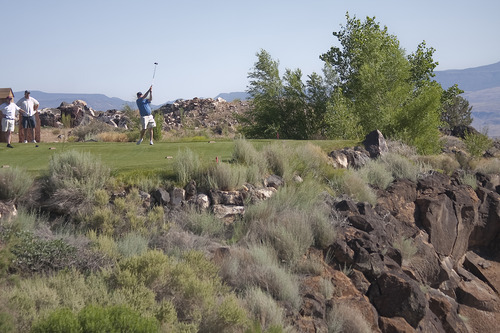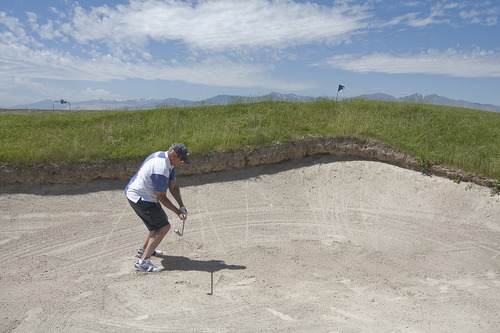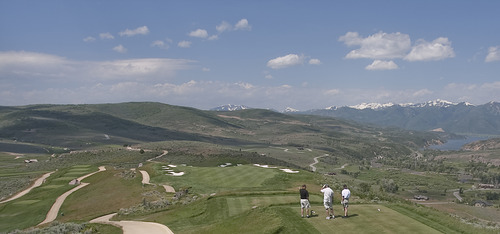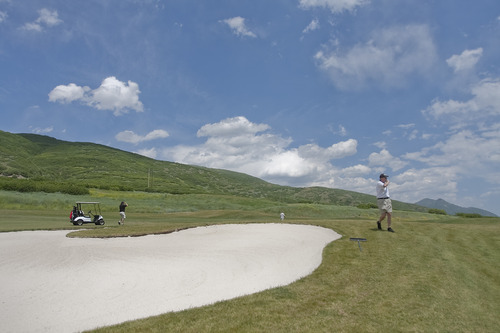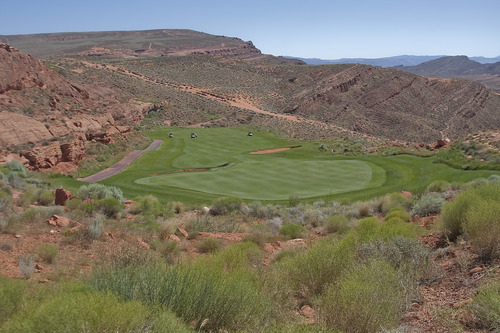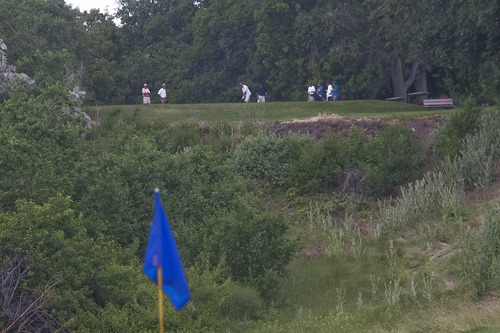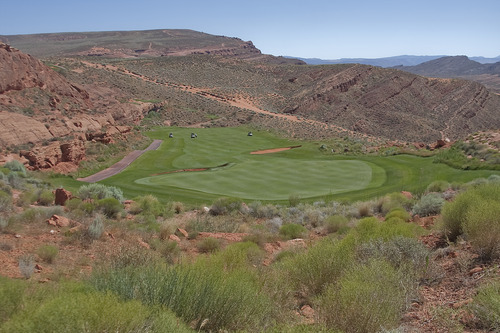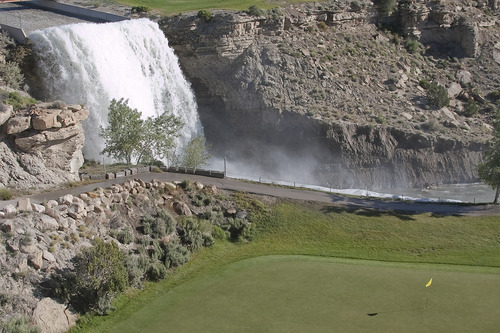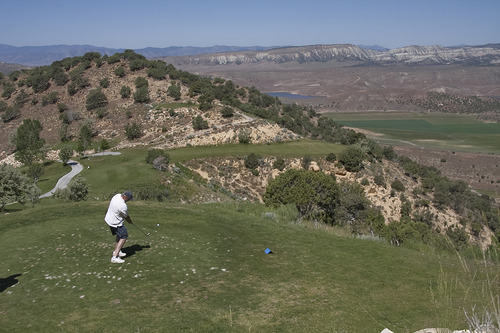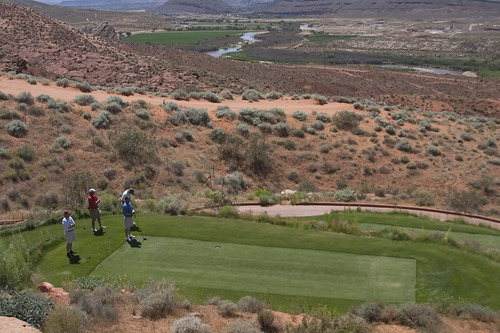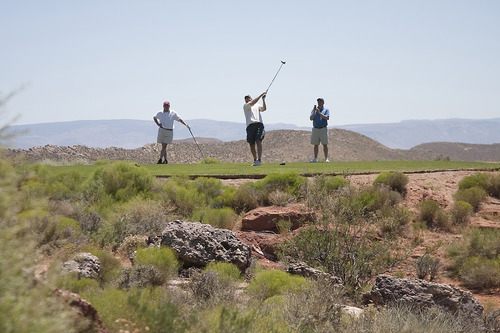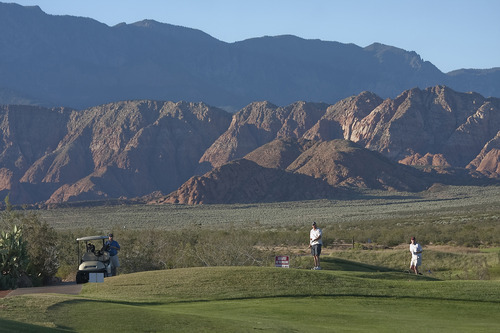This is an archived article that was published on sltrib.com in 2011, and information in the article may be outdated. It is provided only for personal research purposes and may not be reprinted.
This month, the United States Golf Association and the PGA of America have staged a "Tee It Forward" campaign, encouraging recreational golfers to play courses at a length that better suits their abilities and makes the game more enjoyable.
The Salt Lake Tribune took the opposite approach. Three members of the Sports staff selected the 18 toughest holes on Utah public-access courses and played them from the back tees.
Good golf courses have at least one memorable hole, the kind that can define a round and make it memorable. Gordon Monson, Jay Drew and Kurt Kragthorpe played 18 such holes — one at a time.
Utah's "Mean 18" stretches some 7,700 yards, roughly 1,500 yards longer than the middle tees at an average course. Geographically, it stretches 359 miles from Eden to St. George, broken into three one-day trips from Salt Lake City and back. The trek resulted in 1,130 miles driven and 34.5 hours spent in the car and on the courses.
Some holes were chosen purposely to accommodate a mix of five par-3s, eight par-4s and five par-5s for a par-72 course.
In some cases, demanding approach shots make the holes difficult enough, regardless of what tees are played. Other holes were selected because of their maximum length, such as Thanksgiving Point's 678-yard No. 11.
— Hole descriptions by Kurt Kragthorpe | Photos by Margaret Distler
No. 18 at Victory Ranch Golf Club in Woodland
Par • 4
Distance • 520 yards
Hazards • There's a long carry to reach the fairway, which falls off into trouble on both sides.
What makes this hole so tough • The elevated tee is exposed to the wind. A golfer in the twosome behind us arrives at the clubhouse and declares the 18th hole "unplayable" that day because of the left-to-right wind. The yardage is intimidating, although a descent from the tee to the landing area and another drop to the green make it more manageable. The entrance to the green is fairly narrow. The challenge is offset by spectacular views all around.
Relative difficulty • No. 1 of 18.
No. 3 at Wingpointe Golf Course in Salt Lake City
Par • 4
Distance • 451 yards
Hazards • Water comes into play the whole way and there's always a crosswind
What makes this hole so tough • The large lake bordering the left side affects every shot from tee to green. The wind can blow across the fairway from either direction, depending on the time of day. A drive that's steered away from the water can drift over the mounds on the right and into long grass, so picking the right line is critical. A similar challenge applies to the second shot, with a pot bunker on the right.
Relative difficulty • No. 7 of 18.
No. 7 at Millsite Golf Course
Par • 3
Distance • 213 yards
Hazards • Millsite's famous spillway does not come into play, but seems to steer balls to the right.
What makes this hole so tough • The water roaring down the spillway to the right of the green gives the hole a loud, misty atmosphere in the early summer in Ferron, tending to make it play even longer. The green sits high above the tee in a box canyon with a rock wall on the left, and there's a sharp dropoff to the right. The green slopes sharply from back to front.
Relative difficulty • No. 9 of 18.
No. 4 at Palisade State Park
Par • 3
Distance • 179 yards
Hazards • Just one, but it's a biggie, requiring a carry over a canyon in the heart of Utah, near Manti.
What makes this hole so tough • The dramatic drop of 65 feet from the highest tee makes the hole play only about 160 yards, but it is an all-or-nothing shot and the distance must be precise. The green is 49 yards wide but just 11 yards deep in the middle, with the canyon in front and a rock wall in back. It takes courage to shoot at a flagstick on the right side, even though the green is 22 yards deep there.
Relative difficulty • No. 17 of 18.
No. 6 at Green Spring Golf Course
Par • 4
Distance • 449 yards
Hazards • The gorge guarding the green as the hole turns sharply to the right gobbles up balls by the dozens.
What makes this hole so tough • The bridge from the fairway to the green is a striking indication of the gorge's length — and so is the sign prohibiting ball-hunting in the canyon in Washington. Even an ideal drive can leave a second shot of nearly 200 yards across the gorge, and there's hardly any room for error. Just reaching a bail-out area to the right requires a well-struck shot.
Relative difficulty • No. 3 of 18.
No. 11 at Thanksgiving Point Golf Course
Par • 5
Distance • 678 yards
Hazards • From the back tee, the lake looms in front of the fairway and widens as the hole moves south.
What makes this hole so tough • From the white tees, golfers barely notice the lake in Lehi. The hole is still challenging from that starting point, mostly because of bunkers and an undulating green. From the back tee, even taking a conservative line to where the fairway begins requires a good drive. And then there's 400-plus more yards to cover, with a giant bunker protecting the entrance to the green.
Relative difficulty • No. 5 of 18.
No. 15 at Glen Eagle Golf Course
Par • 3
Distance • 200 yards
Hazards • The marsh extends from right in front of the tee to just in front of the green.
What makes this hole so tough • The hole may not be unreasonably long, but it is all carry, creating an intimidating view from the tee in Syracuse. There's a little room on each side of a fairly large green, but even from the white tees, the tee shot must be well hit just to find land. Monson's fairway-wood shot did so, ending up 15 feet from the hole.
Relative difficulty • No. 11 of 18.
No. 9 at Wolf Creek Utah Resort
Par • 5
Distance • 579 yards
Hazards • The pond that extends almost the width of the green makes the approach tricky.
What makes this hole so tough • While not overly long, this hole requires accuracy. Native grass runs down the entire left side in Eden. A bunker on the right frames the landing area, and the combination of a right-to-left sloping fairway and an out-of-bounds area that juts out on the right makes even a layup shot demanding. Inevitably, making sure you clear the pond will result in a downhill putt.
Relative difficulty • No. 15 of 18.
No. 17 (Gold), Soldier Hollow
Par • 5
Distance • 610 yards
Hazards • Trouble on both sides of the fairway and a big bunker fronting the green.
What makes this hole so tough • There's a 160-yard cart path winding between the back tees and the blue markers across a canyon in Midway, so the choice of tees dramatically affects how this hole plays. The drive goes uphill over the canyon to a fairway guarded by bushes on the left and a big, new bunker and other trouble on the right. Even after a decent drive, the second shot is blind.
Relative difficulty • No. 13 of 18.
No. 12 at Sand Hollow Resort in Hurricane
Par • 4
Distance • 443 yards
Hazards • A drop off a cliff to the left; a rock wall on the right.
What makes this hole so tough • The same elements that make this hole visually captivating become frightening from the tee. Any drive to the left goes off the cliff; anything to the right can bounce back into the fairway, but only with some luck. The green rises steeply and is well bunkered, with big rocks to the left that helped Kragthorpe's ball to carom onto the green, leading to a par. That's not the preferred method, however.
Relative difficulty • No. 6 of 18.
No. 16 at Valderra Golf Club in St. George
Par • 5
Distance • 600 yards
Hazards • A sharp slope to the left, out of bounds right.
What makes this hole so tough • The barber pole placed atop the crown of the fairway offers the only real clue about where to aim the drive. The fairway slopes sharply to the left, where all kinds of trouble lies. But a drive that fails to go at least slightly left of the pole can drift out of bounds. The trick is to catch the slope just right. And the fairway splits on the second shot, creating another dilemma.
Relative difficulty • No. 16 of 18.
No. 7, Coral Canyon Golf Course
Par • 4
Distance • 480 yards
Hazards • The desert on the left and the rock wall on the right are in play from tee to green.
What makes this hole so tough • With the fairway sloping from right to left, the landing area is framed by a large bunker on the right and trouble on the left in Washington. The sheer length from the back tee is the biggest challenge of this hole, forcing a long carry to the fairway. The uneven lies in the fairway can bring the desert on the left more into play on the approach shot.
Relative difficulty • No. 18 of 18.
No. 5 (Woodbridge), Sunbrook Golf Course.
Par • 4
Distance • 441 yards
Hazards • Water and rocks surround the landing area, and then there's a lake to cross.
What makes this hole so tough • The wooden bridge that's the namesake of this nine (among Sunbrook's 27 holes in St. George) offers a tiny target in the distance for the tee shot, although it is downhill. No matter how good the drive is, the approach shot to a narrow green is lengthy and there's some thick rough in front. The island green that precedes this hole requires one great shot; this takes two.
Relative difficulty • No. 4 of 18.
No. 11 at Riverbend Golf Course
Par • 5
Distance • 577 yards
Hazards • The sizable marsh in the middle of the fairway shapes the hole.
What makes this hole so tough • The prevailing south wind in Riverton adds length. Trees on the left frame the entire hole and the marsh comes into play on the second shot, so a good tee shot is critical. A short drive results in a difficult layup shot, with little room to skirt around the left side of the marsh. The bushes encroach the left side of the fairway near the green.
Relative difficulty • No. 12 of 18.
No. 6 at Talons Cove Golf Course
Par • 3
Distance • 262 yards
Hazards • Three staggered bunkers in front of the green; native grasses.
What makes this hole so tough • Only from the back tee is this hole overwhelming. There's more room around the green than it appears from the tee, as is typical of a Gene Bates design. But it still takes a well-struck shot just to avoid any of the three staggered bunkers in front of the green. Using a driver, Drew hit the green, with Utah Lake creating a beautiful backdrop in Saratoga Springs.
Relative difficulty • No. 10 of 18.
No. 14, South Mountain Golf Course
Par • 4
Distance • 395 yards
Hazards • Trouble all along the left side; a mountain on the right.
What makes this hole so tough • From the back tee, the dogleg-right turn is so sharp that the 150-yard pole in the middle of the fairway is hidden. Choosing the correct line off the tee is very difficult when the win blows in Draper. The rocks on the right jut out and it's easy to run through the fairway to the left. And the opening to the green is narrow and uphill.
Relative difficulty • No. 2 of 18.
No. 3 at Valley View Golf Course
Par • 4
Distance • 437 yards
Hazards • A pond of lurks on the left, off the tee.
What makes this hole so tough • The deep, slick green is perched starkly above the fairway. The fairway slopes from left to right, but the pond discourages golfers from aiming to the left. The approach shot plays considerably longer because of the elevated green, and even after two excellent shots, the work is just beginning on this hole, which challenged the golfers in this week's State Women's Amateur in Layton.
Relative difficulty • No. 8 of 18.
No. 9 at Bonneville Golf Course
Par • 3
Distance • 182 yards.
Hazards • The fairway slopes toward a bunker and a creek on the right.
What makes this hole so tough • The sloping, two-tiered green features a steep rise that can send a ball back down to the fairway. If the flagstick is on the top shelf, the Salt Lake City course's former finishing hole plays at least a half-stroke harder. Everything bounces to the left, but there's only a tiny bail-out area between the green and the cart path on the left. All kinds of trouble is on the right.
Relative difficulty • No. 14 of 18. —
Utah's 18 toughest golf holes



